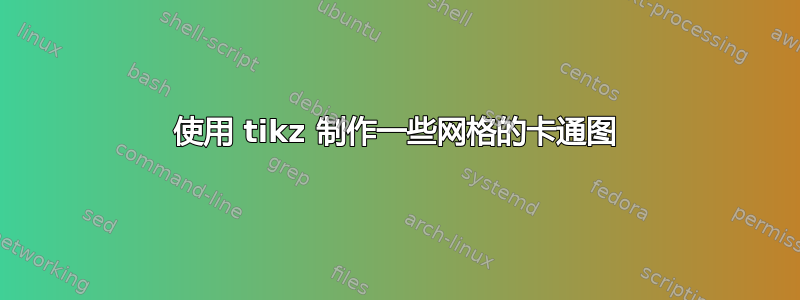
我想使用 latex 生成类似下图的图形 使用
使用tikzpicture。
例如使用给出的例子这里
\documentclass{article}
\usepackage{tikz}
\begin{document}
\begin{tikzpicture}
\def\BITARRAY{
{0,0,1,1,1},
{1,1,1,0,0},
{0,0,1,1,1},
{1,0,0,1,0},
{1,1,1,0,0},
{1,1,1,1,1},
{0,0,1,1,1},
{0,0,1,1,1}%
}
\fill[red]
\foreach \row [count=\y] in \BITARRAY {
\foreach \cell [count=\x] in \row {
\ifnum\cell=1 %
(\x-1, -\y+1) rectangle ++(1, -1)
\fi
\pgfextra{%
\global\let\maxx\x
\global\let\maxy\y
}%
}
}
;
\draw[thin] (0, 0) grid[step=1] (\maxx, -\maxy);
\end{tikzpicture}
\end{document}
我可以生成网格,但如何添加标签并将网格放在一起?是否可以通过 latex 完成?
答案1
这里有一个建议:定义一个合适的pic并使用它。这允许您使用定位库在其周围放置东西。
\documentclass{article}
\usepackage{tikz}
\usetikzlibrary{positioning}
% based on https://tex.stackexchange.com/questions/315313/dynamically-filling-a-grid-with-tikz-from-a-data-array?noredirect=1&lq=1 and https://tex.stackexchange.com/a/311441/121799
\tikzset{
pics/BitArray/.style n args={2}{
code={\begin{scope}[#2]
\fill
\foreach \row [count=\y] in {#1} {
\foreach \cell [count=\x] in \row {
\ifnum\cell=1 %
(\x-1, -\y+1) rectangle ++(1, -1)
\fi
\pgfextra{%
\global\let\maxx\x
\global\let\maxy\y
}%
}
}
;
\draw[thin] (0, 0) grid[step=1] (\maxx, -\maxy);
\end{scope}
}
}
}
\begin{document}
You can either work with \texttt{local bounding boxes} in a
\texttt{tikzpicture}\\
\begin{tikzpicture}
\begin{scope}[local bounding box=BA1]
\pic {BitArray={%
{0,0,1,1,1},
{1,1,1,0,0},
{0,0,1,1,1},
{1,0,0,1,0},
{1,1,1,0,0},
{1,1,1,1,1},
{0,0,1,1,1},
{0,0,1,1,1}%
}{fill=red,scale=0.5}};
\end{scope}
\node[above=1pt of BA1] {$k$};
\node[left=1pt of BA1.north west] {$X$};
\node[left=1pt of BA1.west] {$N$};
\begin{scope}[local bounding box=BA2,scale=0.5]
\pic[right=3cm of BA1.north east] {BitArray={%
{0,0,1,1,1},
{1,1,1,0,0},
{0,0,1,1,1},
{1,0,0,1,0},
{1,1,1,0,0},
{1,1,1,1,1},
}{fill=blue,scale=0.5}};
\end{scope}
\node[above=1pt of BA2] {$\ell$};
\end{tikzpicture}\\
or use equations
\[
\begin{tikzpicture}[baseline=(N.base)]
\begin{scope}[local bounding box=BA1,scale=0.5]
\pic {BitArray={%
{0,0,1,1,1},
{1,1,1,0,0},
{0,0,1,1,1},
{1,0,0,1,0},
{1,1,1,0,0},
{1,1,1,1,1},
{0,0,1,1,1},
{0,0,1,1,1}%
}{fill=red,scale=0.5}};
\end{scope}
\node[above=1pt of BA1] {$k$};
\node[left=1pt of BA1.north west] {$X$};
\node[left=1pt of BA1.west] (N) {$N$};
\end{tikzpicture}
~\sim~
\begin{tikzpicture}[baseline=(N2.base)]
\begin{scope}[local bounding box=BA2,scale=0.5]
\pic[right=3cm of BA1.north east] {BitArray={%
{0,0,1,1,1},
{1,1,1,0,0},
{0,0,1,1,1},
{1,0,0,1,0},
{1,1,1,0,0},
{1,1,1,1,1},
}{fill=blue,scale=0.5}};
\end{scope}
\node[above=1pt of BA2] {$\ell$};
\node[left=1pt of BA2.west] (N2) {$N$};
\end{tikzpicture}
~\dots~
\begin{tikzpicture}[baseline=(dots.base)]
\begin{scope}[local bounding box=BA3,scale=0.5]
\pic[right=3cm of BA1.north east] {BitArray={%
{0,0,1,1,1},
{1,1,1,0,0},
{0,0,1,1,1},
}{fill=cyan,scale=0.5}};
\end{scope}
\node[below=1pt of BA3.south] (dots) {$\vdots$};
\end{tikzpicture}
\]
\end{document}



